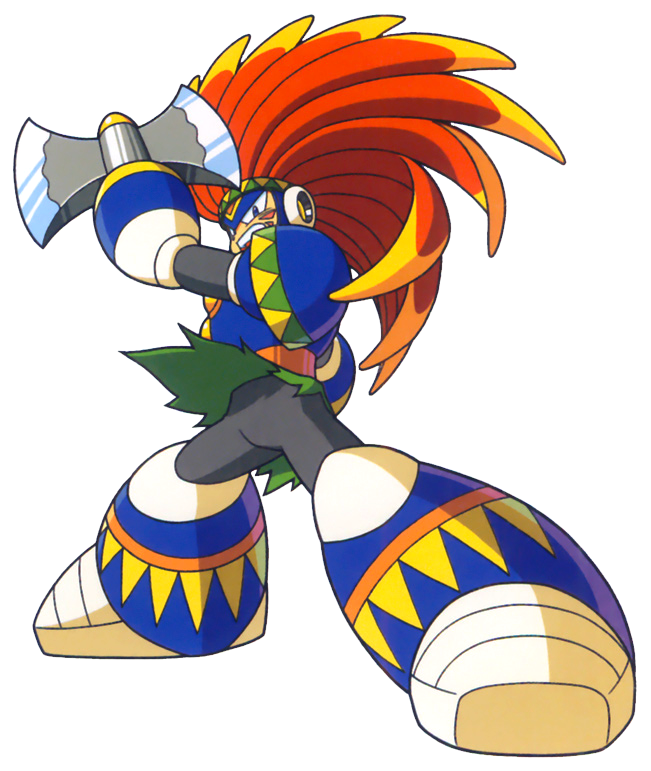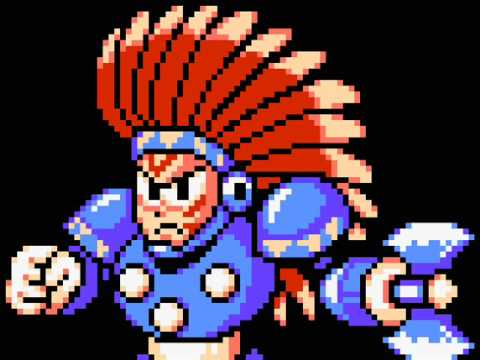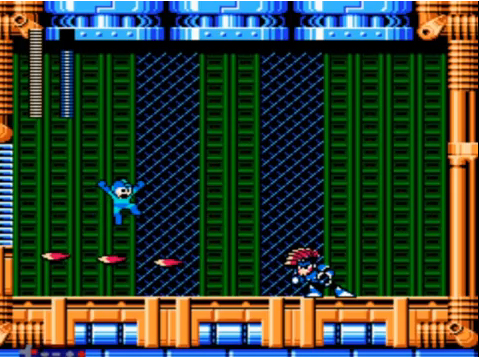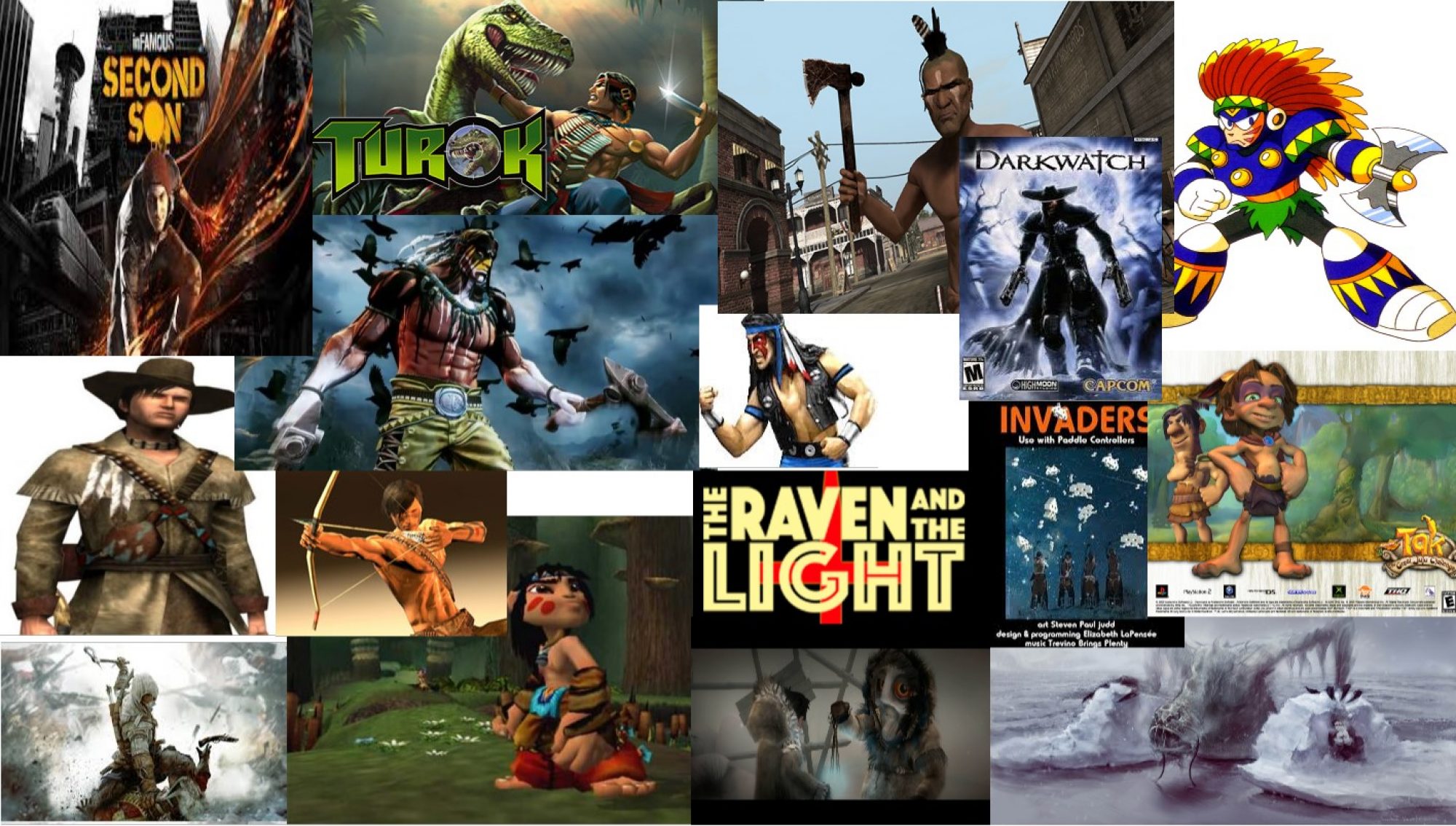
Tomahawk Design. Image taken from:http://megaman.wikia.com/wiki/Tomahawk_Man
The Mega Man series has been a part of video game history for over 30 years. Initially, starting out on the iconic Nintendo Entertainment System in 1987, the series followed player controlled cyborg Mega Man as he defended the world from invading robots controlled by the evil scientist Dr. Wily. The player will venture through multiple stages, where if successfully defeating the boss, will earn said bosses unique weapon to use to in their future progression of the game. The boss characters themselves are robots that follow different themes (Fire man, Ice man) where the environments revolve around their abilities. The characteristics of the environment play a significant role in the Indigenous representation of Tomahawk Man’s character in Mega Man 6.

Inital starting location of Tomahawk Man’s stage. Image taken from: http://www.themmnetwork.com/blog/2014/12/22/a-critical-look-at-mega-man-6-stages-tomahawk-man
During Tomahawk Man’s stage, the player sees the layout of the level through depictions of cactus and deep canyons, and sunset filled skies filling the backgrounds as the player traverses the stage from left to right. The first enemies that the player interacts with are the cowboy hat wearing robots that continue to shoot at Mega Man until the player eliminates them. The player must traverse through the stage by jumping over pits and spikes that will kill the player if touched or entered.

Transition from Western to futuristic settings. Image taken from: http://www.themmnetwork.com/blog/2014/12/22/a-critical-look-at-mega-man-6-stages-tomahawk-man
Crossing Tomahawk Man’s stage depicts the transition of the player from a “dated” western themed location (starting location) to an area filled with robotic caverns and structures that completely change the theme of the previously mentioned portion of the level. The futuristic robotic parts of the level depict nothing associated with the first cactus and canyon background images seen when the stage begins. The starting scene feels like the stereotypical location of Hollywoods Western themed Cowboy and Indian movies are known for, finalizing into a futuristic catacomb of machines. The foreignness of machines in both the Western setting and the caverns (futuristic setting) of the stage depicts the Native American stereotype as something unreal. The only way the Native American exists is through presenting him as a robot.

Tomahawk Man depicted with red war paint, headress and silver tomahawk. Image taken from: https://i.ytimg.com/vi/3WmBsvi8QIg/hqdefault.jpg
Both sections of the stage are shown within one pixelated character art as to the impact mentioned earlier. That depiction is through the stages final boss Tomahawk Man. The character himself is a robot, which Dr. Wily, the main series villain, controls. The robot design has features that encapsulate reinforced stereotypes of Native Americans. These features are shown through both; a large red and white feathered headdress, and a tomahawk as his primary weapon to attack. The game uses familiar stereotypical symbols to attribute Tomahawk Man as a Native American, disassociating important stories, teachings, and cultures connected to those symbols. “Native American mascots misrepresent, distort and trivialize many aspects of Native American cultures, such as drumming, dancing, singing, and some aspects of religion” (King, 25). Most people who support mascots do not understand the meaning or realities of Native American lives and cultures (King). “ The mascots and most other images of Native Americans in popular culture lump all nations (i.e., “tribes”) of Native Americans together, incorrectly conveying that there is a single Native American culture and rendering the diversity of Native American cultures invisible” (King, 25). Additionally, the boss characters face is painted with red lines to represent red paint that many Native American characters used in modern movies to reinforce their warrior status.

The great battle between Mega Man and Tomahawk Man. Image taken from: https://i.ytimg.com/vi/3WmBsvi8QIg/hqdefault.
It is important to note that it is not only how Tomahawk man looks like, but also what the character does during fights that also reinforce negative stereotypes. For example, during battle, Tomahawk Man will throw silver Tomahawks at Mega Man but also uses a quicker attack, throwing silver feathers. Upon defeating Tomahawk Man, Mega Man receives the special power Silver Tomahawk that he can use the rest of the game. The depiction of feathers and tomahawks used as weapons reinforces the savage warrior representation of Tomahawk Man.
The headdress and the tomahawk show the use of stereotypical modern media symbols of Native Americans. These familiar symbols are what many non-Indigenous people relate to identifying who or what is Indigenous. To put these stereotypical symbols on a character the player must defeat, symbolizes the continued removal and colonization of the Native American “savage.” The player only sees a “Native American” as a fantasy, similarly and comparatively displayed with robots. Depicting them as something foreign to the player like robots, only mimicking what the programmers want them to act. When showing only tomahawks, headdresses as well as depicting the Native Americans as savage warriors through their pixelated head dresses and war paint, illustrates Native American peoples as a culture of fantasy.
Sources:
King, Richard. The Native American Mascot Controversy: A Handbook. The Rowman & Littlefield Publishing Group, 2010.

